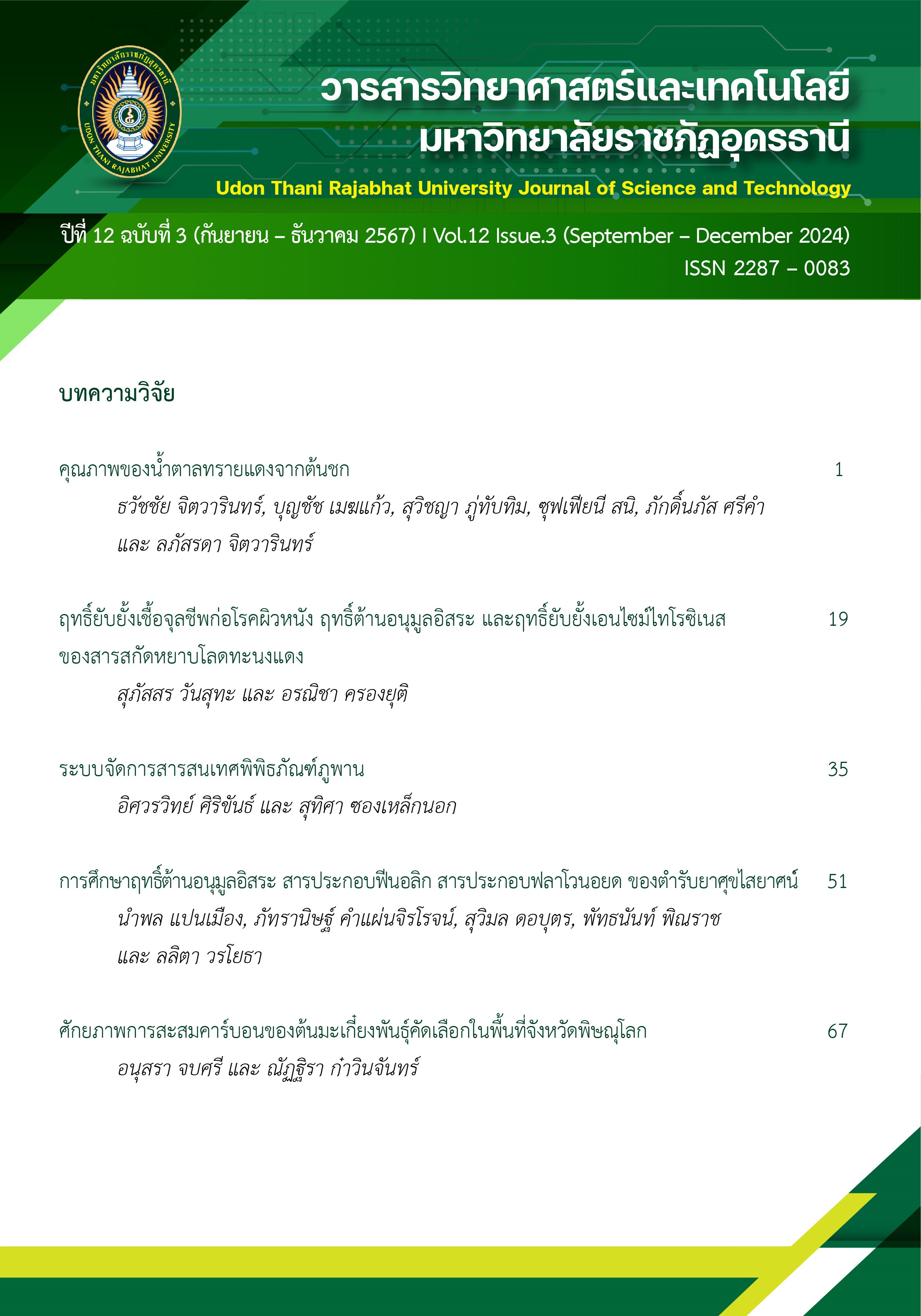ANTIMICROBIAL SKIN PHATHOGENS, ANTI-OXIDANT AND ANTI-TYROSINASE ACTIVITIES OF TRIGONOSTEMON REIDIOIDES (KURZ) CRAIB CRUDE EXTRACTS
Main Article Content
Abstract
Trigonostemon reidioides (Kurz) Craib or Lod-thanong-deang was Thai traditional herb that properties of detoxifying, antivenin, bruise, sprains and swelling. This research aimed to determine antimicrobial, antioxidant, tyrosinase, total flavonoids content and total phenolics content of Lod-thanong-deang. The extracts were prepared by using solvents 95% ethanol. The anti-microorganisms was determined by broth microdilution method and antioxidant activity was determined by 2, 2-diphenyl-1-picrylhydrazyl (DPPH assay). From the results, it was found that inhibit on 3 strains of microorganisms were Candida albicans ATCC10231 (MIC: 31.25 mg/mL, MBC: 31.25 mg/mL), Staphylococcus aureus ATCC25923 and Pseudomonas aeruginosa ATCC27853 (MIC: 250 mg/mL, MBC: 500 mg/mL) respectively Therefore, Lod-thanong-deang extracted inhibition and antimicrobial activity. Antioxidant activity determined by DPPH assay (IC50 value of 623.28±7.37 µg/mL) compared with ascorbic acid. Moreover, it exhibited the strongest tyrosinase inhibition activity (IC50 value of 809.63±65.22 µg/mL) compared with Kojic acid, which was statistically significantly different (p-value < 0.05) and the highest total phenolic and flavonoid content (total flavonoids content to 18.66±0.07 mg QE/g extract and total phenolics content to 10.22±0.13 mg GAE/g extract). This research demonstrates that Lod-thanong-deang is considered to be an interesting source of bioactive compounds and may be an alternative herb for cosmetic applications for value herbs alternative products for consumers.
Article Details
References
กรมการแพทย์แผนไทยและการแพทย์ทางเลือก. (2561). สมุนไพรแก้แมลงสัตว์กัดต่อย. วารสารกรมการแพทย์แผนไทยและการแพทย์ทางเลือก, 1(4), 1-10.
กรมควบคุมโรค. (2556). ตำราวัคซีนและการสร้างเสริมภูมคุ้มกันโรค. มหาวิทยาลัยราชภัฎสวนสุนันทา.
กรมวิชาการ. (2542). คัมภีร์แพทย์ศาสตร์สงเคราะห์ภูมิปัญญาทางการแพทย์และมรดกทางวรรณกรรมของชาติ. องค์การค้าคุรุสภา.
จินดาพร คงเดช. (2551). การผลิตสารยับยั้งเอนไซม์ไทโรซิเนส และสารต้านอนุมูลอิสระจากพืชเพื่อใช้ในเครื่องสำอาง. (วิทยานิพนธ์ปริญญามหาบัณฑิต, มหาวิทยาลัยเทคโนโลยี พระจอมเกล้าธนบุรี).
ดวงแก้ว ปัญญาภู และ กฤษณะ คตสุข. (2561). โลดทะนงแดงสมุนไพรแก้พิษงู. วารสารกรมการแพทย์แผนไทยและการแพทย์ทางเลือก, 1(4), 11-20.
พรรณี หนูซื่อตรง, ดวงเดือน เมฆสุริเยนทร์ และ บุญรัตน์ จันทร์ทอง. (2551). กลไกความเป็นพิษของสารสกัดโลดทะนงแดงในเซลล์เอ็มบริโอพีสิบเก้า. (รายงานวิจัยฉบับสมบูรณ์). กรุงเทพฯ: จุฬาลงกรณ์มหาวิทยาลัย.
พรพิมล พลคำ, ศรินทร์ ทองธรรมชาติ, ทองสุข พละมา, มนชวัน วังกุลางกูร และ สุชนา วานิช. (2561). การศึกษาเปรียบเทียบแบบแผนโปรตีนของพืชสมุนไพรต้านพิษแมลงสัตว์กัดต่อย ด้วยวิธี Electrophoresis. (รายงานวิจัยฉบับสมบูรณ์). มหาสารคาม: มหาวิทยาลัยราชภัฏมหาสารคาม.
รัตนา อินทรานุปกรณ์. (2547). การตรวจสอบและการสกัดแยกสารสำคัญจากสมุนไพร. กรุงเทพฯ: สำนักพิมพ์แห่งจุฬาลงกรณ์มหาวิทยาลัย.
Balouiri, M., Sadiki, M., & Ibnsouda, S.K. (2016). Methods for in vitro evaluating antimicrobial activity: A review. Journal of Pharmaceutical Analysis, 6(2), 71-79.
Birben, E., Sahiner, U.M., Sackesen, C., Erzurum, S., & Kalayci, O. (2012). Oxidative Stress and Antioxidant Defense. World Allergy Organ Journal, 5(1), 9–19.
Carlsen, M. H., Halvorsen, B. L., & Holte, K. (2010).The total antioxidant content of than 3100 foods, beverages, spices, herbs and supplements used worldwide. Nutrition Journal, 9(3), 1-11.
Chan, E. W. C., Lim, Y. Y., Wong, L. F., Lianto, F. S., Wong, S. K., Lim, K. K., Joe, C. E. & Lim, T. Y. (2008). Antioxidant and tyrosinase inhibition properties of leaves and rhizomes of ginger species. Food Chemistry, 109, 477–483.
Chang, Q., Zuo, Z., Harrison, F., & Chow, M. S. S. (2002). Hawthorn. Journal of Clinical Pharmacology, 42(6), 605-612.
Chu, Y.H., Chang, C. L., & Hsu, H. F. (2000). Flavonoid content of several vegetables and their antioxidant activity. Journal of the Science of Food and Agriculture, 80, 561-566.
Itah, A. & Essien, J. (2005). Growth profile and hydrocarbon clastic potential of microorganisms isolated from Tarballs in the Bight of Bonny, Nigeria. World Journal of Microbiology and Biotechnology, 21(7), 1317-1322.
Jayasuriya, H., Zink, D. L., Borris, R. P. Nanakorn, W., Beck, H. T., Balick, M. J., Goetz, M. A., Gregory, L., Shoop, W. L., & Singh, S. B. (2004). Rediocides B-E, potent insecticides from Trigonostemon reidioides. Journal of Natural Products, 67(2), 228-231.
Kaemchantuek, P., Chokchaisiri, R., Prabpai S., Kongsaeree, P., Chunglok, W., Utaipan, T., Chamulitrat, W., & Suksamrarn, A. (2017). Terpenoids with potent antimycobacterial activity against Mycobacterium tuberculosis from Trigonostemon reidioides roots. Tetrahedron, 73(12), 1594-1601.
Pandey, A. & Tripathi, S. (2014). Concept of standardization, extraction and pre phytochemical screening strategies for herbal drug. Journal of Pharmacognosy and Phytochemistry, 2(5), 115-119.
Peters, B.M., Jabra-Rizk, M.A., Scheper M.A., Leid, J. G., Costerton, J. W., & Shirtliff, M. E. (2010). Microbial interactions and differential protein expression in Staphylococcus aureus - Candida albicans dual-species biofilms. FEMS Immunology and Medical Microbiology, 59(3), 493–503.
Sangdee, A., Sangdee, K., Bunchalee, P., & Seephonkai, P. (2021). Antibacterial activity and mechanism of action of trigonostemone against Staphylococcus aureus and Bacillus cereus. Tropical Biomedicine, 38(4), 484-490.
Sharma, B. R., Kumar, V., Gat, Y., Kumar, N., Parashar, A., Pinakin, D. J. (2018). Microbial maceration: a sustainable approach for phytochemical extraction. 3 Biotech, 8(9), 401. doi: 10.1007/s13205-018-1423-8.
Singleton, V. L. & Rossi, J. A. (1965). Colorimetry of total phenolics with phosphomolybdic phosphotungstic acid reagents. American Journal of Enology and Viticulture, 16, 144.
Utsintong, M., Talley, T. T., Taylor, P. W., Olson, A. J., & Vajragupta, O. (2009). Virtual Screening Against α-Cobratoxin. Journal of Biomolecular Screening, 14(9), 1109–1118.


